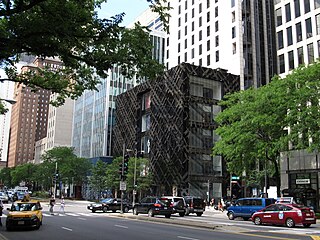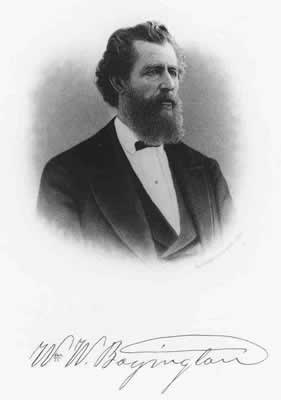
Jane Margaret Byrne was an American politician who served as the 50th mayor of Chicago from April 16, 1979, until April 29, 1983. Prior to her tenure as mayor, Byrne served as Chicago's commissioner of consumer sales from 1969 until 1977, the only female in the mayoral cabinet.

The John Hancock Center is a 100-story, 1,128-foot super tall skyscraper located in Chicago, Illinois. Located in the Magnificent Mile district, the building was officially renamed 875 North Michigan Avenue in 2018.

Buckingham Fountain is a Chicago Landmark in the center of Grant Park, between Queen's Landing and the end of Ida B. Wells Drive. Dedicated in 1927 and donated to the city by philanthropist Kate S. Buckingham, it is one of the largest fountains in the world. Built in a rococo wedding cake style and inspired by the Latona Fountain at the Palace of Versailles, its design allegorically represents nearby Lake Michigan. The fountain operates generally from mid-April to mid-October, with regular water-jet shows and evening colored-light shows. During the winter, the fountain is decorated with festival lights.

A water tower is an elevated structure supporting a water tank constructed at a height sufficient to pressurize a distribution system for potable water, and to provide emergency storage for fire protection. Water towers often operate in conjunction with underground or surface service reservoirs, which store treated water close to where it will be used. Other types of water towers may only store raw (non-potable) water for fire protection or industrial purposes, and may not necessarily be connected to a public water supply.

Lemont is a village located in Cook, DuPage, and Will counties in the U.S. state of Illinois, and is a south-west suburb of Chicago. The population was 17,629 as of the 2020 census. The village is situated on a hillside along the south banks of the Des Plaines River. It overlooks Waterfall Glen's Midwestern Bluff Savanna on the opposite side. Lemont is home to Argonne National Laboratory and other heavy industrial sites, and has a substantial European immigrant population.

Michigan Avenue is a north-south street in Chicago that runs at 100 east on the Chicago grid. The northern end of the street is at Lake Shore Drive on the shore of Lake Michigan in the Gold Coast Historic District. The street's southern terminus is at Sibley Boulevard in the southern suburb of Dolton, but like many other Chicago streets, it exists in several disjointed segments.

The Magnificent Mile, sometimes referred to as The Mag Mile, is an upscale section of Chicago's Michigan Avenue, running from the Chicago River to Oak Street in the Near North Side. The district is located within downtown and one block east of Rush Street. The Magnificent Mile serves as the main thoroughfare between Chicago's Loop business district and its Gold Coast. It is generally the western boundary of the Streeterville neighborhood, to its east, and of River North to the west.

The Edgewater Beach Hotel was a resort hotel complex on Lake Michigan in the far-north neighborhood community of Edgewater in Chicago, Illinois, designed by Benjamin H. Marshall and Charles E. Fox. The first multi-story building was built in 1916, for its owners John Tobin Connery and James Patrick Connery, located between Sheridan Road and Lake Michigan at Berwyn Avenue in a Spanish Revival style. An adjacent south tower building was added in 1924, with a low connecting passageway-building to serve as reception and additional public rooms. The resort, which included beaches, pools, clubs, and gardens hosted famous movie and sports stars, and later Martin Luther King Jr. The hotel was also the setting for the celebrity stalking case and shooting that inspired the novel and movie The Natural. The hotel buildings closed in 1967, and were soon after demolished.

William Warren Boyington was an architect who designed several notable structures in and around Chicago, Illinois. He was also mayor of Highland Park, Illinois.

The Leaning Tower of Niles is a half-size replica of the Leaning Tower of Pisa located in Niles, Illinois. Designed by architect Albert L. Farr and completed in 1934, it was commissioned by industrialist Robert Ilg as part of a recreation park for employees of the Ilg Hot Air Electric Ventilating Company of Chicago. It is situated at 6300 W. Touhy Avenue.

The Washington Park Zoo is a zoo located in Washington Park, Michigan City, Indiana, which covers 15 acres (61,000 m2) on a hilly sand dune close to the southeastern tip of Lake Michigan. The park and zoo were listed in the National Register of Historic Places in 1991.

The Beloit water tower is a historic octagonal limestone water tower completed in 1889 in Beloit, Wisconsin.

The Old Chicago Water Tower District is a historic district along the Magnificent Mile shopping district in the Near North Side community area of Chicago, Illinois. The district is located on both sides of North Michigan Avenue between East Chicago and East Pearson Streets. It includes the Chicago Water Tower, Chicago Avenue Pumping Station, and Chicago Fire Department Fire Station No. 98. All three structures are part of the Chicago Landmark district designated on October 6, 1971. The Water Tower and Pumping Station were jointly added to the National Register of Historic Places on April 23, 1975. In addition the Tower was named an American Water Landmark in 1969. The Water Tower was also one of the few buildings to survive the Great Chicago Fire. The district is the namesake of the nearby Water Tower Place.

The Chicago Avenue Pumping Station is a historic district contributing property in the Old Chicago Water Tower District landmark district. It is located on Michigan Avenue along the Magnificent Mile shopping district in the Near North Side community area of Chicago, Illinois. It is on the east side of Michigan Avenue opposite the Chicago Water Tower.

University Hall is the oldest original building on the Northwestern University campus in Evanston, Illinois, and the second building to have been constructed after Old College, which stood on campus until the 1970s. The building has served a wide range of different roles since its construction, and currently houses the university's English department.

The Sears, Roebuck and Company Complex is a building complex in the community area of North Lawndale in Chicago, Illinois. The complex hosted most of department-store chain Sears' mail order operations between 1906 and 1993, and it also served as Sears' corporate headquarters until 1973, when the Sears Tower was completed. Of its original 40-acre (16 ha) complex, only three buildings survive and have been adaptively rehabilitated to other uses. The complex was designated a National Historic Landmark in 1978, at which time it still included the 3,000,000-square-foot mail order plant, the world's largest commercial building when it was completed. That building has been demolished, its site taken up by the Homan Square redevelopment project.

The Rochester Downtown Historic District is a historic district on the National Register of Historic Places (NRHP) in Rochester, Indiana, United States. It was placed on the Register on June 24, 2008. The majority of buildings in the area are masonry and Italianate while structures outside the district are largely residential frame built structures.

The Manistique Pumping Station is an industrial waterworks building located on Deer Street in Manistique, Michigan. It was listed on the National Register of Historic Places in 1981.

The Charles Spangenberg Farmstead is a historic farm in Woodbury, Minnesota, United States, established in 1869. The three oldest buildings, including an 1871 farmhouse, were listed together on the National Register of Historic Places in 1978 for having local significance in the theme of agriculture. The property was nominated for being one of Washington County's few remaining 19th-century farmsteads.

Reads Landing School is a former school building in the unincorporated community of Reads Landing, Minnesota, United States. Built in 1870, it has been converted into the Wabasha County Historical Society Museum. The building is one of the state's oldest surviving brick schools, and typifies their characteristic boxy, bracketed, Italianate style. The school was listed on the National Register of Historic Places in 1989 for having local significance in the themes of architecture and exploration/settlement. It was nominated for being a rare surviving example of Minnesota's early brick schools, and for its association with Reads Landing's peak as a lumber milling boomtown.























